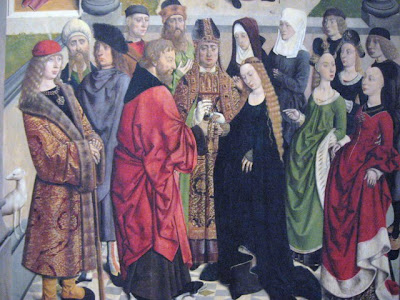A couple of other things I noticed: on each side, there is one person looking away from the ceremony. Pictures such as this were painted very carefully; they are not snapshots. A lot of time and effort went into them, so the artist had very deliberate reasons for posing his figures the way he did. I wonder what the reason was for that. Also, the priest is wrapping a band of fabric around the joined hands of Mary and Joseph. This custom is the origin of our "hand fast" ceremonies of folk song fame. the root of "fast," in this sense is the same as our modern "fastened," or "made safe."

Joseph's footwear is wonderful. He is wearing pattens, which I had heard described, but never seen. They were wooden, a cross between a clog and a flip-flop, and worn over soft shoes. The tiled floor is interesting, also.

I'm guessing these people represent Mary's family. Aren't they a fashionable bunch of Medieval lords and ladies? The younger ladies display the elegant headgear and tweezed foreheads that we see in tapestries of the period, and the older lady in the back has her head covered. Maybe she is a servant. There is something under their skirts, resembling hoops or multitudinous petticoats, that creates that bell shape. The bodices are nicely draped, showing off their young curves.

Here is a close up of their faces. None of them looks very happy about this marriage. I'm sure the artist would have thought that, in Biblical times, Mary would have had trouble convincing Joseph of her Annunciation story. I think the Bible tells us that Joseph was visited by the angel in a dream; so it took some heavenly persuasion. Perhaps that's why Mary is dressed in black.

Here's a closer look at Joseph's family and friends. They are all pretty glum, too. I like the man in the white turban. His staring eyes make me wonder if the phrase, "If any man can show just cause why these two should not be joined together in the bonds of Holy Matrimony, let him speak now or forever hold his peace," was a part of the ceremony. He looks as if he is biting something back. His beard looks like a refugee from "Braveheart!"

I had no trouble remembering that the contemporary audience for this painting was, for the most part, illiterate. The people learned the story from their local priest, and from pictures such as this. Hence the large amount of detail. The faces may have been portraits of real lords and ladies of the time, who may have contributed to the cost.
An Art museum is a Wonderful Place.
These are great! Leave it to you to notice all the wonderful costuming details!
ReplyDelete...t
A kind of superficial view, but I did pick up a bit.
ReplyDeleteDid you notice the hand in the armpit of the girl in red? I think the guy behind her is holding her up.
ReplyDeleteThat's more likely than my thought--that it was some Medieval way of copping a feel...
ReplyDeleteI think Chandra is right. Maybe she was fainting from the joyous, incredible news and he was holding her up! Remember, the artist was informing the masses here about the annunciation, etc.
ReplyDeleteKing Tut is at the Children's Museum this summer! I can't wait to go.
ReplyDeleteI never would have noticed all those nuances in that painting. Made me look at it in a totally different way than I normally would have.
It's that costumer's eye, Lisa...I love the stories these pictures tell, about the way they looked at the Bible in those days, and about how they saw their own world. Bible stories were much more immediate back then, as almost everyone was illiterate, and there wasn't a lot else around to read for those who could.
ReplyDeleteI wish I could see King Tut with you!
The shoes are to die for. I found some links to more pattens here. Check out the second link and think about walking in those!
ReplyDeletehttp://www.larsdatter.com/pattens.htm
Bookmarked, Nadine! Thank you very much for the link. The have information on a lot of late Medieval stuff...I can't imagine balancing on those...it would be like roller-blading without the rollers...
ReplyDelete